Before considering the atomic bomb vs nuclear bomb difference, Let’s Find Out About Bomb. The term “bomb” refers to an explosive device designed to release a sudden and violent burst of energy, often with the purpose of causing destruction, damage, or harm. Bombs can come in various shapes, sizes, and types, each with its specific use and impact. Here are some common types of bombs.
Before introducing this, let us consider the Atomic Bomb Vs Nuclear Bomb Difference one by one…
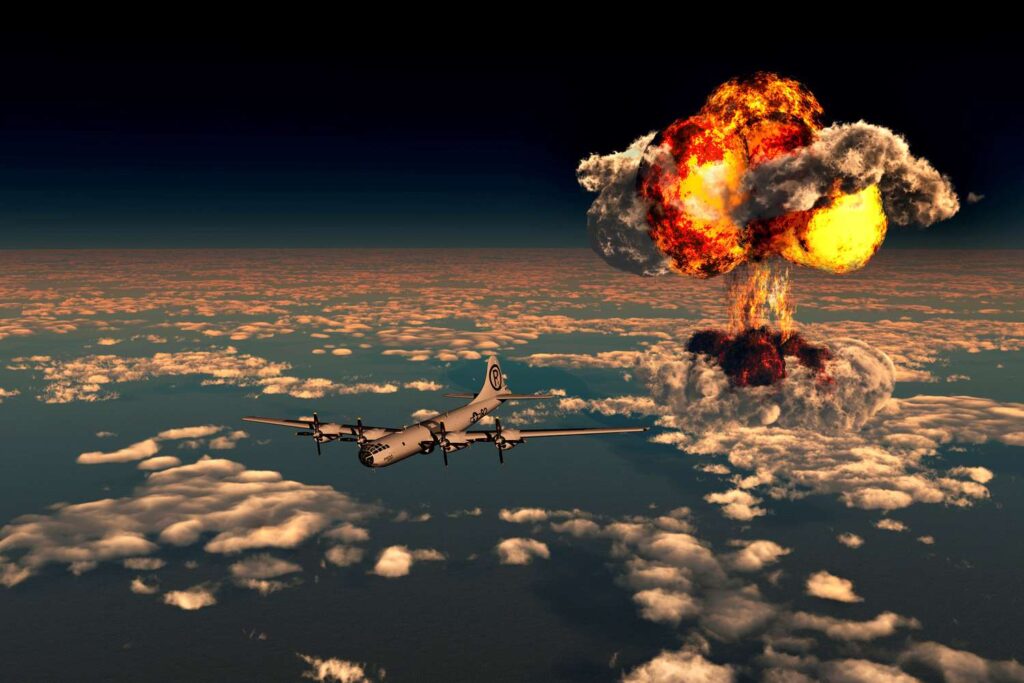
- Conventional Bomb: Conventional bombs use chemical explosives, such as TNT (trinitrotoluene), to generate an explosion. These bombs have been used in warfare for many decades and are employed by military forces for tactical and strategic purposes.
- Improvised Explosive Device (IED): An IED is a homemade bomb constructed from non-military-grade components. They are often used by insurgents and terrorists and can be highly unpredictable and deadly.
- Incendiary Bomb: An incendiary bomb is designed to start fires and can be used to target buildings, vehicles, or areas with flammable materials. They are particularly effective in causing widespread destruction.
- Cluster Bomb: A cluster bomb releases multiple smaller submunitions or bomblets over a wide area, increasing its destructive potential. Cluster bombs have been criticized for their impact on civilians, as unexploded bomblets can remain dangerous long after the conflict ends.
- Nuclear Bomb: As explained earlier, a nuclear bomb uses nuclear reactions (either fission or fusion) to release an immense amount of energy. It is one of the most powerful and devastating weapons ever created.
- Chemical Bomb: A chemical bomb is designed to disperse harmful chemical substances, such as nerve agents or mustard gas, into the environment, causing injury or death to humans and animals.
- Biological Bomb: A biological bomb, also known as a bioweapon, is designed to release biological agents like bacteria, viruses, or toxins to cause disease and harm to living organisms.
- Dirty Bomb: A dirty bomb is a conventional explosive combined with radioactive material. The goal is not necessarily to cause a nuclear explosion but to disperse radioactive particles over a wide area, creating fear and contamination.
It’s important to note that the use of bombs, especially those with indiscriminate effects, can result in significant harm to civilians, damage to infrastructure, and long-lasting environmental consequences. International law and treaties have been established to regulate and prohibit the use of certain types of bombs to protect civilians and minimize the impact of armed conflicts.
…………………………………………………………………………………………………………………………………………………….
Atomic Bomb
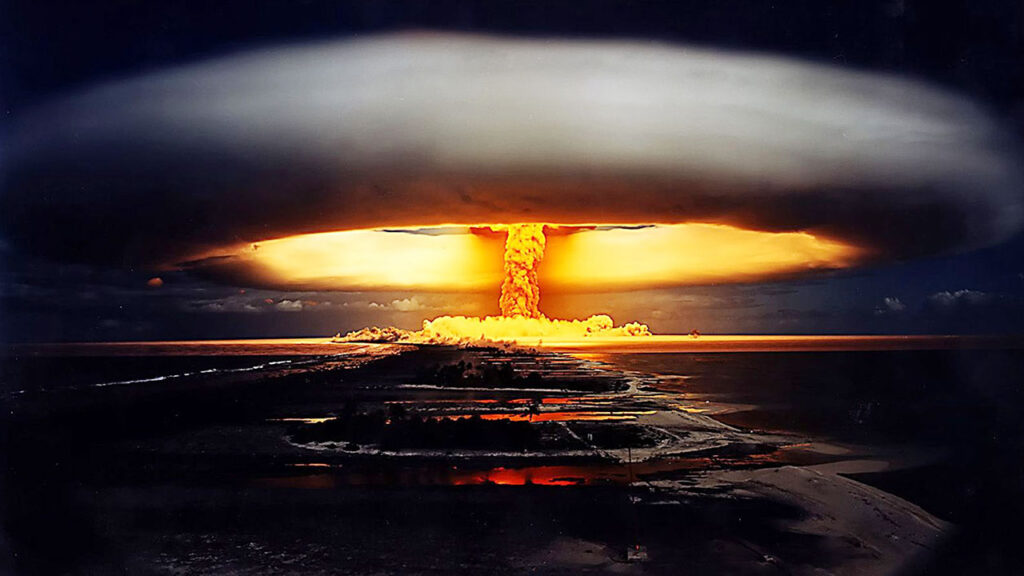
An atomic bomb, also known as an A-bomb, is a type of nuclear weapon that relies on nuclear fission to release an enormous amount of energy in the form of a powerful explosion. The destructive force of an atomic bomb is derived from the release of nuclear energy through the process of nuclear fission.
The basic components of an atomic bomb include:
- Fissile Material: The core of an atomic bomb contains fissile material, such as enriched uranium-235 or plutonium-239. These materials can undergo nuclear fission, where the nucleus of an atom is split into two smaller nuclei, releasing a tremendous amount of energy.
- Initiators: Initiators, also known as neutron initiators or triggers, are used to start the chain reaction of nuclear fission. They release neutrons to strike and initiate the fission process in the fissile material.
The process of detonating an atomic bomb involves assembling a critical mass of fissile material and triggering a controlled chain reaction of nuclear fission. When the atomic bomb is detonated, the fissile material rapidly undergoes fission, releasing an immense amount of energy in the form of a powerful explosion.
The effects of an atomic bomb detonation are devastating and include:
- Blast Wave: The explosion produces a powerful shockwave that causes widespread destruction of structures and infrastructure in the vicinity of the blast.
- Heat and Fire: The intense heat generated by the explosion can ignite fires, causing further damage to buildings and spreading rapidly.
- Radiation: The explosion results in the release of ionizing radiation, which can cause immediate injuries and long-term health effects to exposed individuals.
- Mushroom Cloud: The explosion creates a distinctive mushroom-shaped cloud formed from the rising hot air, water vapor, and debris.
The use of atomic bombs in warfare is a subject of great controversy and ethical debate due to their catastrophic consequences. The only two instances of atomic bombs being used in warfare occurred during World War II when the United States dropped atomic bombs on the Japanese cities of Hiroshima and Nagasaki in August 1945. The bombings resulted in a significant loss of life and long-term health effects for survivors, and they marked the beginning of the end of World War II.
Since then, there have been international efforts to control the proliferation of nuclear weapons and promote disarmament through treaties and agreements, such as the Treaty on the Non-Proliferation of Nuclear Weapons (NPT). The use of nuclear weapons is now widely considered a last resort option due to the catastrophic humanitarian consequences they can inflict.
Atomic Bomb History
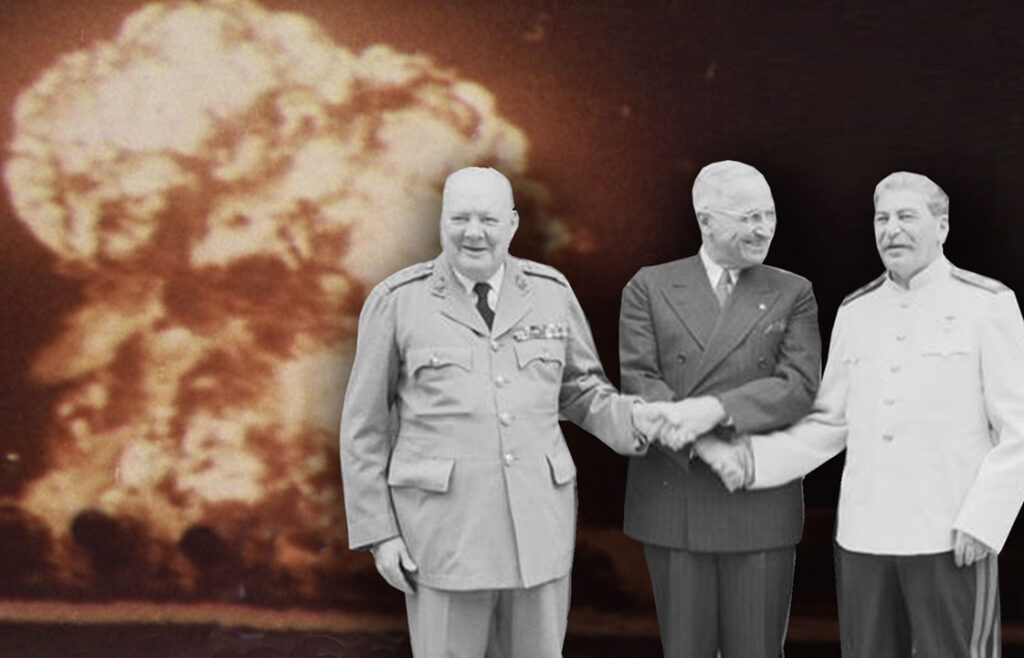
The history of the atomic bomb is a pivotal chapter in human history, marked by scientific advancements, the culmination of the Manhattan Project, and the use of atomic weapons during World War II. Here are the key events in the history of the atomic bomb:
- Discovery of Nuclear Fission: In 1938, German physicists Otto Hahn and Fritz Strassmann discovered nuclear fission, the process by which the nucleus of an atom is split into two smaller nuclei, releasing a large amount of energy. The theoretical explanation for nuclear fission was provided by Lise Meitner and Otto Frisch.
- Einstein-Szilárd Letter: In 1939, Hungarian physicist Leo Szilárd and physicist Albert Einstein sent a letter to U.S. President Franklin D. Roosevelt, warning about the possibility of Nazi Germany developing atomic weapons. This letter prompted the U.S. government to initiate research into nuclear weapons, leading to the establishment of the Manhattan Project.
- Manhattan Project: In 1942, the Manhattan Project was launched by the United States under the leadership of J. Robert Oppenheimer. The project’s primary objective was to develop an atomic bomb before Nazi Germany or any other Axis powers could do so.
- Development and Testing: The Manhattan Project involved a massive, top-secret research effort that brought together some of the world’s brightest scientists and engineers. It took place in several locations across the United States, with key sites including Los Alamos, New Mexico, and Oak Ridge, Tennessee.
On July 16, 1945, the first successful test of an atomic bomb, codenamed “Trinity,” was conducted at the Trinity Test Site in New Mexico. The successful detonation of the bomb demonstrated the viability of nuclear weapons.
- Atomic Bombings of Hiroshima and Nagasaki: In the final stages of World War II, the United States dropped atomic bombs on the Japanese cities of Hiroshima and Nagasaki. On August 6, 1945, an atomic bomb named “Little Boy” was dropped on Hiroshima, resulting in the immediate death of tens of thousands of people and widespread destruction.
On August 9, 1945, a second atomic bomb named “Fat Man” was dropped on Nagasaki, causing further devastation and loss of life. These bombings had a profound impact on Japan and led to the country’s surrender, effectively ending World War II.
- The Aftermath: The use of atomic bombs in Hiroshima and Nagasaki had devastating consequences for the people living in those cities. Many died immediately from the explosions and thermal effects, and thousands more succumbed to injuries, radiation sickness, and long-term health effects in the following years.
- Nuclear Arms Race: Following World War II, the U.S. and the Soviet Union entered into a period of intense competition known as the nuclear arms race. Both countries developed and tested more powerful and sophisticated nuclear weapons, leading to a buildup of nuclear arsenals and the development of a strategy called “Mutually Assured Destruction” (MAD).
- Non-Proliferation Efforts: In the decades following World War II, concerns about the spread of nuclear weapons led to the establishment of the Treaty on the Non-Proliferation of Nuclear Weapons (NPT) in 1970. The NPT aimed to prevent the proliferation of nuclear weapons and promote disarmament.
The atomic bomb’s history highlights the tremendous power of nuclear weapons and their impact on global politics and security. The use of atomic bombs in Japan remains a subject of ongoing historical debate and ethical discussions about the use of nuclear weapons in warfare. Since the end of World War II, there have been significant international efforts to prevent the use of nuclear weapons and work toward nuclear disarmament.
Read This For More Details=
Atomic Bomb Creator | How the Atomic Bomb Destroyed the Life of its Creator
…………………………………………………………………………………………………………………………………………………….
Nuclear Bomb
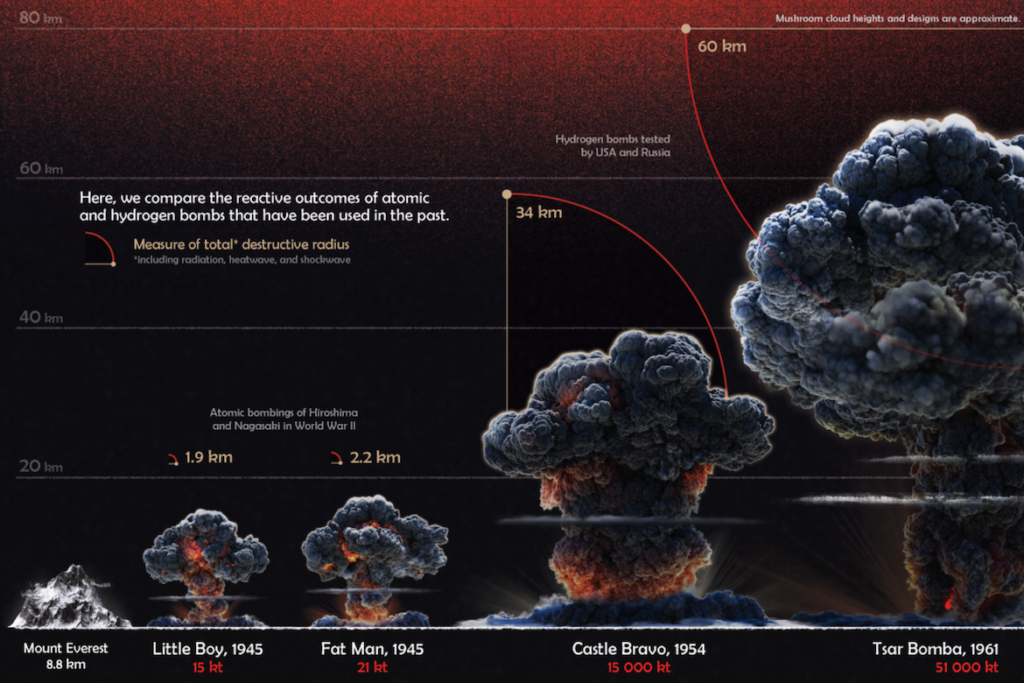
A nuclear bomb, also known as a nuclear weapon or nuke, is a type of explosive device that derives its destructive power from nuclear reactions. It is one of the most powerful and devastating weapons ever created by humankind. Nuclear bombs can be classified into two main types: atomic bombs and hydrogen bombs (thermonuclear bombs).
- Atomic Bomb (A-Bomb): An atomic bomb relies on nuclear fission to release an immense amount of energy. In nuclear fission, the nucleus of a heavy atom, such as uranium-235 or plutonium-239, is split into two smaller nuclei, accompanied by the release of a significant amount of energy. This energy is released in the form of a powerful explosion.
The process of detonating an atomic bomb involves assembling a critical mass of fissile material (uranium or plutonium) and initiating a chain reaction of nuclear fission. This chain reaction results in the rapid release of energy, leading to the devastating blast characteristic of atomic bombs.
The first and only instances of atomic bombs being used in warfare were during World War II when the United States dropped atomic bombs on the Japanese cities of Hiroshima and Nagasaki in August 1945.
- Hydrogen Bomb (H-Bomb or Thermonuclear Bomb): A hydrogen bomb, also known as a thermonuclear bomb, is a more advanced and powerful type of nuclear weapon. It uses a two-stage process involving both nuclear fission and nuclear fusion to release an exponentially greater amount of energy than an atomic bomb.
The primary stage of a hydrogen bomb is similar to an atomic bomb, using nuclear fission to generate the necessary temperature and pressure for the fusion reaction. In the secondary stage, the intense heat and pressure from the fission explosion initiate nuclear fusion, where isotopes of hydrogen (deuterium and tritium) combine to form helium, releasing an extraordinary amount of energy.
Hydrogen bombs are significantly more powerful than atomic bombs and can have yields equivalent to millions of tons of TNT, making them some of the most destructive devices ever conceived.
The use of nuclear bombs in warfare is highly controversial due to their catastrophic consequences. The bombings of Hiroshima and Nagasaki demonstrated the horrifying impact of nuclear weapons, leading to significant global efforts to control the spread of nuclear weapons and prevent their use through arms control agreements and non-proliferation treaties. The fear of a nuclear exchange during the Cold War era further highlighted the need for arms control and disarmament measures to prevent a global nuclear catastrophe.
Nuclear Bomb History
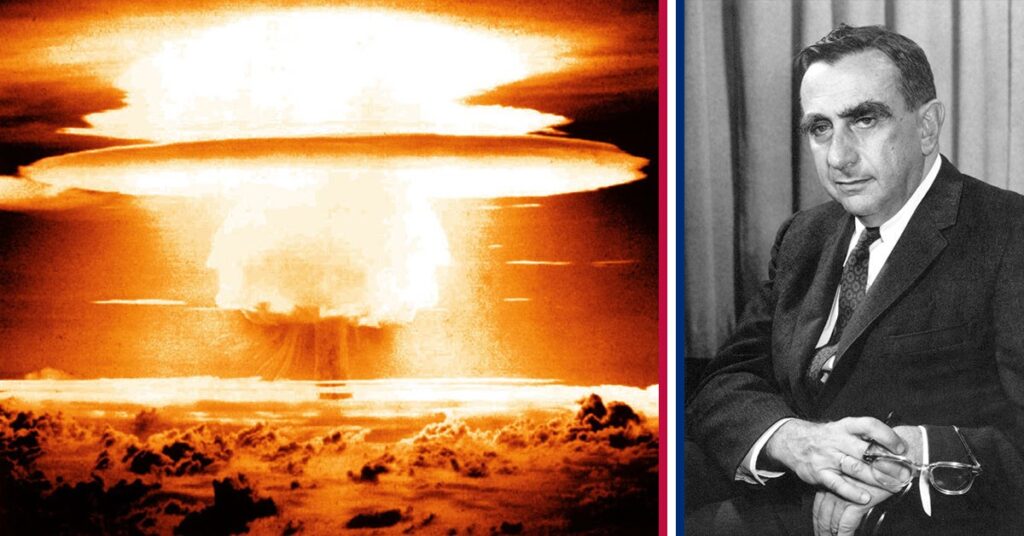
The history of nuclear bombs is a complex and significant aspect of the 20th and 21st centuries, marked by scientific breakthroughs, geopolitical tensions, and the devastating consequences of their use. Here are some key milestones and events in the history of nuclear bombs:
- Discovery of Nuclear Fission: The theoretical basis for nuclear fission, the process at the core of nuclear bombs, was established in 1938 by German physicists Otto Hahn and Fritz Strassmann, who discovered the nuclear fission of uranium. Their findings were confirmed and explained by Lise Meitner and Otto Frisch.
- Manhattan Project: In 1939, fearing that Nazi Germany might develop nuclear weapons, the United States initiated the top-secret Manhattan Project. Led by J. Robert Oppenheimer, the project’s goal was to develop atomic bombs. It involved a massive collaborative effort by scientists, engineers, and military personnel.
- Trinity Test: On July 16, 1945, the first successful test of an atomic bomb took place at the Trinity Test Site in New Mexico. The bomb, codenamed “Gadget,” was an implosion-type plutonium bomb. This test marked the first detonation of a nuclear bomb in history.
- Atomic Bombing of Hiroshima and Nagasaki: On August 6 and 9, 1945, the United States dropped atomic bombs on the Japanese cities of Hiroshima and Nagasaki, respectively, during World War II. The bombings resulted in the immediate deaths of tens of thousands of people and caused long-term health effects due to radiation exposure. These events played a significant role in Japan’s surrender and the end of World War II.
- Nuclear Arms Race: After World War II, the United States and the Soviet Union emerged as the world’s superpowers and engaged in a nuclear arms race, developing and testing more powerful and sophisticated nuclear weapons. This period of intense nuclear competition led to the buildup of vast nuclear arsenals.
- Treaty on the Non-Proliferation of Nuclear Weapons (NPT): The NPT was opened for signature in 1968 and entered into force in 1970. It aims to prevent the spread of nuclear weapons and promote nuclear disarmament. It divides countries into nuclear-weapon states (recognized nuclear powers) and non-nuclear-weapon states (non-nuclear states).
- Cold War Nuclear Standoff: During the Cold War, the U.S. and the Soviet Union maintained a delicate balance of nuclear deterrence known as “Mutually Assured Destruction” (MAD). Both sides understood that using nuclear weapons could lead to catastrophic consequences, which helped prevent direct conflict between the superpowers.
- Development of Hydrogen Bombs: In the 1950s, both the U.S. and the Soviet Union developed hydrogen bombs, also known as thermonuclear bombs. These bombs utilized nuclear fusion, making them exponentially more powerful than atomic bombs.
- Nuclear Tests and Arms Reductions: Throughout the latter half of the 20th century and into the 21st century, various nuclear tests were conducted by different countries. However, there have also been significant efforts to reduce nuclear arsenals through arms control treaties and agreements.
- Proliferation Concerns: Since the end of the Cold War, there have been concerns about nuclear proliferation, with several countries acquiring nuclear weapons or pursuing nuclear programs. The international community has sought to address these concerns through diplomatic means and non-proliferation efforts.
The history of nuclear bombs reflects the tremendous power and risks associated with these weapons. The devastating impact of the bombings of Hiroshima and Nagasaki led to global efforts to control and prevent the use of nuclear weapons, but the continued presence of nuclear arsenals remains a major global security challenge. Diplomatic efforts, arms control agreements, and disarmament initiatives continue to be crucial in mitigating the risks posed by nuclear weapons.
…………………………………………………………………………………………………………………………………………………….
Difference Between Nuclear Bomb and Atomic Bomb
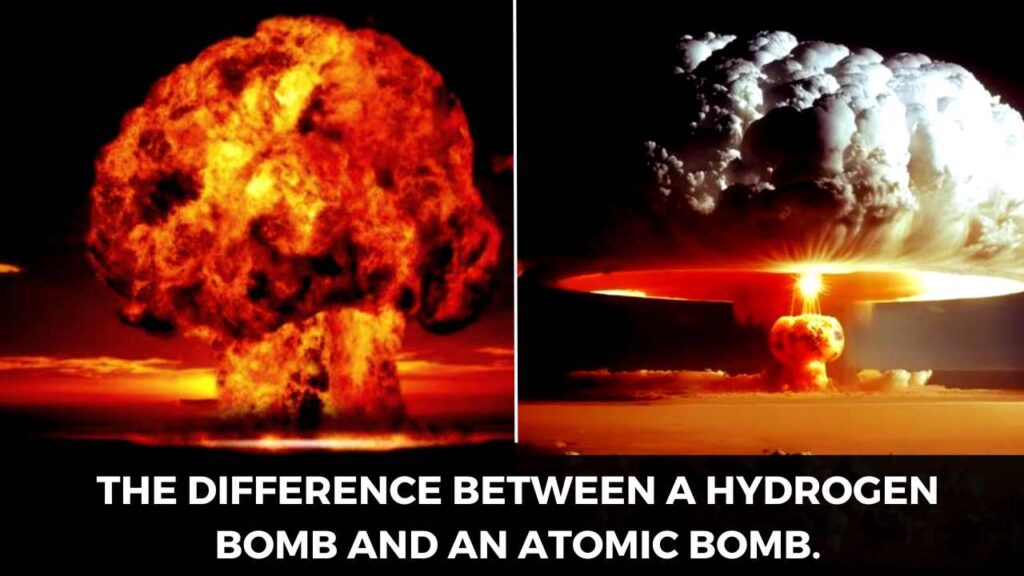
- Atomic Bomb: An atomic bomb is a type of nuclear weapon that relies on nuclear fission to release an immense amount of energy. In an atomic bomb, the nucleus of a heavy atom (usually uranium-235 or plutonium-239) is split into two smaller nuclei, releasing a massive amount of energy in the form of an explosion. This process is known as nuclear fission. The energy released by the fission reaction causes an explosive chain reaction, leading to a powerful and destructive blast.
- Nuclear Bomb: The term “nuclear bomb” is a broader term that encompasses both atomic bombs and hydrogen bombs. While atomic bombs rely on nuclear fission, hydrogen bombs (also known as thermonuclear bombs) use a two-stage process involving both nuclear fission and nuclear fusion.
In a nuclear bomb, the first stage is similar to an atomic bomb, where nuclear fission occurs to initiate the fusion reaction. Then, the second stage involves nuclear fusion, where light atomic nuclei, usually isotopes of hydrogen (deuterium and tritium), combine to form a heavier nucleus, releasing an even greater amount of energy than nuclear fission alone.
In summary, all atomic bombs are a type of nuclear bomb, but not all nuclear bombs are atomic bombs. Nuclear bombs include both atomic bombs, which rely solely on nuclear fission, and hydrogen bombs, which use a combination of nuclear fission and nuclear fusion to achieve much higher yields and destructive power. Both types of bombs are extremely dangerous and have devastating consequences when detonated.
……………………………………………………………………………………………………………………………………………………
Atomic Bomb vs Nuclear Bomb Which is More Powerful
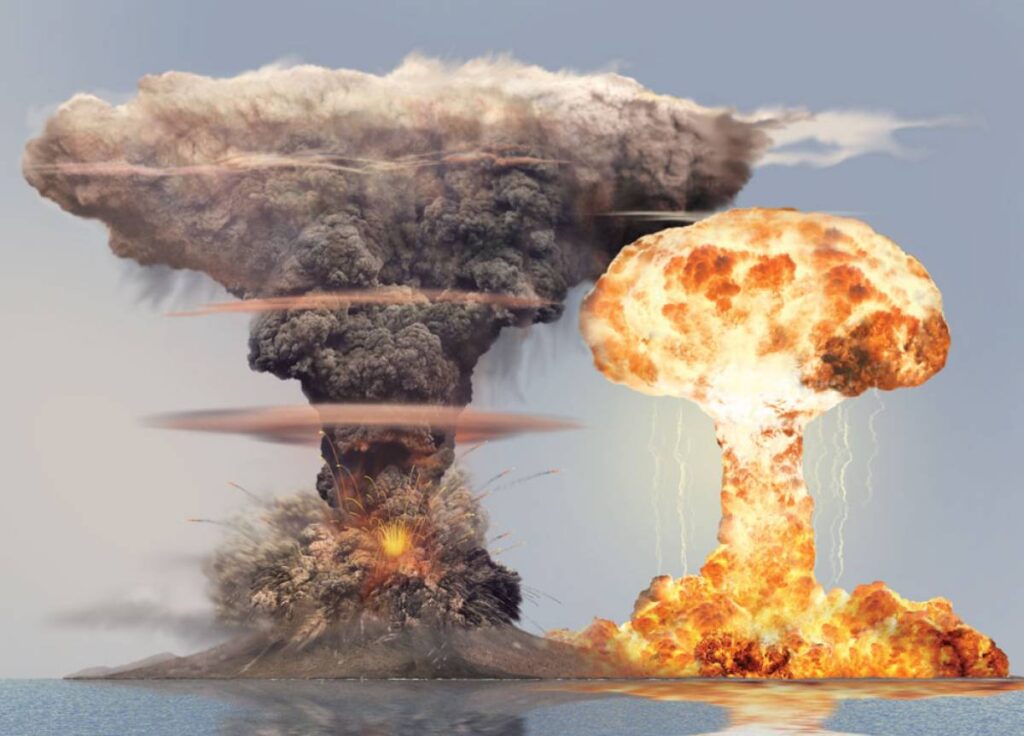
The terms “atomic bomb” and “nuclear bomb” are often used interchangeably, and both refer to explosive devices that release energy through nuclear reactions. Technically speaking, there is no inherent difference in terms of power between an atomic bomb and a nuclear bomb. In fact, both terms can describe the same type of weapon.
Both atomic bombs and hydrogen bombs (thermonuclear bombs) are examples of nuclear bombs. They release energy by harnessing the power of nuclear reactions, either nuclear fission (as in atomic bombs) or a combination of nuclear fission and nuclear fusion (as in hydrogen bombs).
- Atomic Bomb (A-Bomb): An atomic bomb relies solely on nuclear fission to release energy. The nucleus of a heavy atom, such as uranium-235 or plutonium-239, is split into two smaller nuclei, accompanied by the release of a large amount of energy. The energy released from nuclear fission leads to a powerful explosion, which is the characteristic feature of atomic bombs.
- Hydrogen Bomb (H-Bomb or Thermonuclear Bomb): A hydrogen bomb, on the other hand, is a more advanced and powerful type of nuclear bomb. It utilizes a two-stage process involving both nuclear fission and nuclear fusion to release an exponentially greater amount of energy than an atomic bomb.
In the primary stage of a hydrogen bomb, nuclear fission is used to generate the necessary temperature and pressure for the fusion reaction. In the secondary stage, the intense heat and pressure from the fission explosion initiate nuclear fusion, where isotopes of hydrogen (deuterium and tritium) combine to form helium, releasing an extraordinary amount of additional energy.
Because of the fusion component, hydrogen bombs are significantly more powerful than atomic bombs. Hydrogen bombs can have yields equivalent to millions of tons of TNT, whereas atomic bombs have lower yields, typically in the range of thousands of tons of TNT.
To summarize, both atomic bombs and hydrogen bombs are types of nuclear bombs, and the distinction lies in the method of energy release. Hydrogen bombs are more powerful due to the added energy from nuclear fusion, but both types of bombs are capable of causing immense destruction and have devastating consequences if used.
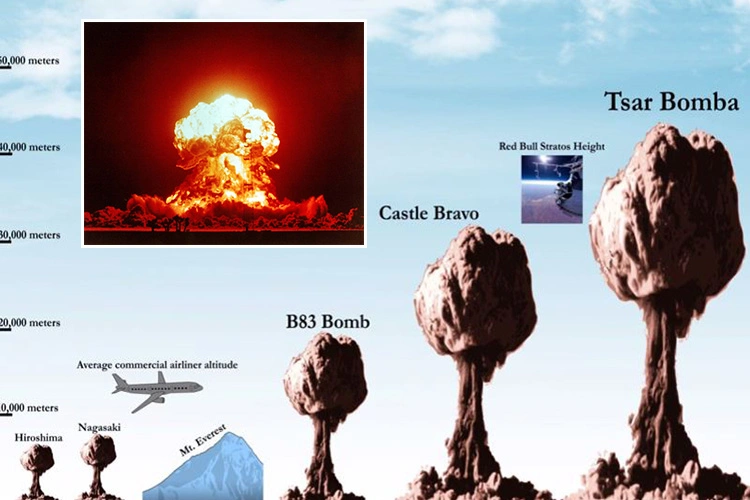
…………………………………………………………………………………………………………………………………………………….
How to Make Nuclear Bomb

In principle it’s very easy – get a critical mass of radioactive material, sit back and watch the runaway nuclear reaction go. But luckily for us it’s the first part – getting the radioactive material – that is the biggest stumbling block.
“You cannot make a nuclear bomb without fissile material,” says Andrew Furlong, of the Institute of Chemical Engineers. And for an average thermonuclear device, the necessary material is plutonium or enriched uranium.
Uranium, a naturally-occurring heavy metal, comes as uranium 238 or 235. Both are radioactive and will decay into other elements, given time, but only the latter can be forcibly split when neutrons are fired at it. This is the basis of a nuclear bomb.
When an atom breaks apart, it gives out energy and more neutrons, which can then split other atoms. Get enough atoms splitting and you have the chain reaction needed for a bomb blast.
But natural uranium overwhelmingly consists of the 238 isotope, which bounces back any neutrons striking it – useless then for a bomb. To make a bomb, natural uranium needs to be treated to concentrate the 235 isotope within it.
And this is where the problems re ally begin. For every 25,000 tonnes of uranium ore, only 50 tonnes of metal are produced. Less than 1% of that is uranium 235. No standard extraction method will separate the two isotopes because they are chemically identical.
Instead, the uranium is reacted with fluorine, heated until it becomes a gas and then decanted through several thousand fine porous barriers. This partially separates the uranium into two types. One is heavily uranium 235, and called “enriched” while the rest is the controversial “depleted” uranium used to make conventional weapons.
To make a nuclear reactor, the uranium needs to be enriched so that 20% of it is uranium 235. For nuclear bombs, that figure needs to be nearer 80 or 90%. Get around 50kg of this enriched uranium – the critical mass – and you have a bomb. Any less and the chain reaction would not cause an explosion.
You could use plutonium instead. According to Keith Barnham, a physicist at Imperial College, this is the preferred material because it makes much lighter weapons that can be mounted on to missiles.
Plutonium is produced as a by-product in nuclear reactors and only around 10kg is needed for a bomb. An average power plant needs about a year to produce enough and expensive reprocessing facilities are required to extract the plutonium from the fuel.
With the basic material, life gets easier. The bomb will explode once the critical mass of uranium or plutonium is brought together. So, to begin with, and to make sure that it doesn’t explode in the hands of its owners, the bomb needs to keep the metal separated into two or more parts. When the weapon is in place and ready to go off, these sub-critical masses need only be thrown together – and this can be done with conventional explosives.
We hope you enjoy this article about Atomic Bomb Vs Nuclear Bomb Difference. Please share, comment, and pin. Anyone can use our article ‘Atomic Bomb Vs Nuclear Bomb Difference’ for studies things.
Related Articles-
Top 10 Best Hosting Services 2023
How To Take Milky Way Photos | Complete Guide 2023
What Is Extended Reality (XR) ? Everything You Need To Know 2023…
What Is The Law Of Attraction ? How To Use It 2023…
How To Get Your Brain To Focus And Concentration 10 Ways 2023
Ceylebrity News And Blog- WWW.CEYLEBRITYNEWS.COM
Visit Our Online Shopping Website- WWW.CEYLEBRITY.COM
Ceylebrity Sinhala News And Articles- WWW.CEYLEBRITYNEWS.L
Share.......
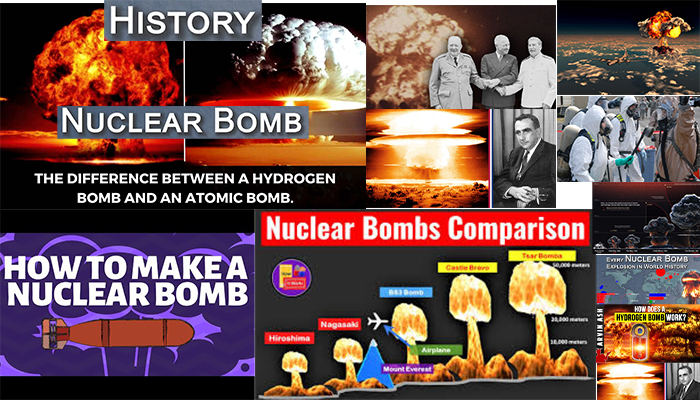



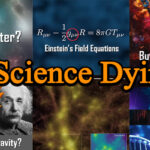
11 thoughts on “Atomic Bomb Vs Nuclear Bomb Difference”